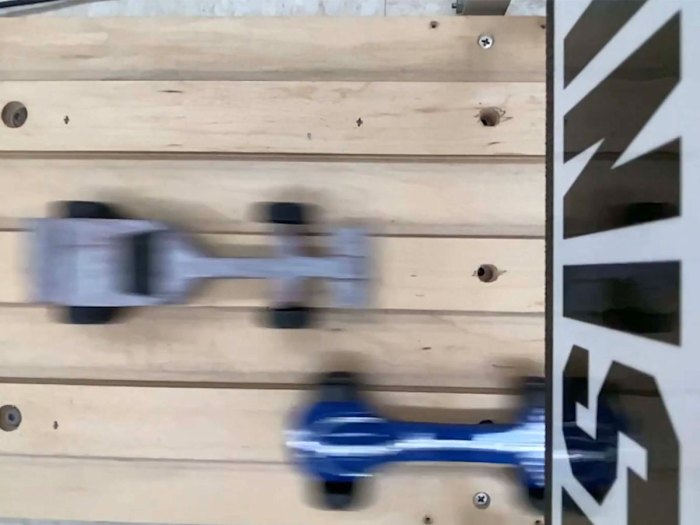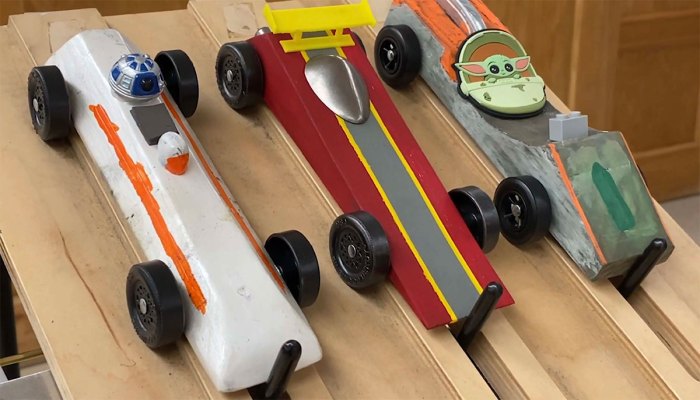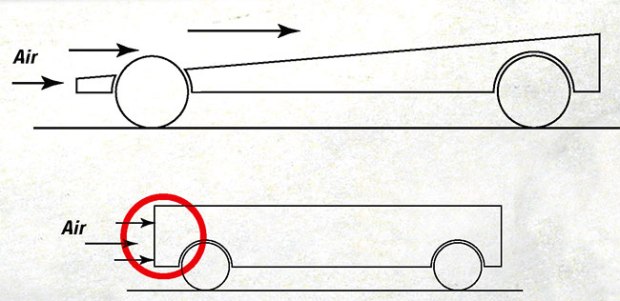How to Make a Fast Pinewood Derby Car

Packs nationwide are gearing up for their annual Pinewood Derby. There are a variety of ways to make your Pinewood Derby car go faster. Explore the following tips to optimize your car’s performance and gain a competitive edge in an upcoming race.
BASIC GUIDELINES FOR PINEWOOD DERBY CAR DESIGN
The possibilities are endless when it comes to picking a shape for your Pinewood Derby car. Before you begin, consider the following general guidelines:
Avoid Pointed Noses: A pointed nose will make it difficult for your Pinewood Derby car to rest on the pin at the starting gate. It may also cause your Pinewood Derby car to get bumped around when the pin drops, and it can create problems for electronic timing systems at the finish line.
Weight Distribution: Leave ample wood in the rear of the Pinewood Derby car so you can place additional weight there. Concentrate the majority of the weight in the rear for optimal performance.
Maximum Weight: Aim for the maximum allowable weight, typically limited to 5 ounces in most races. If your car falls short of this weight, strategically add coins or other weights to meet the requirement.
Clarity in Orientation: Clearly distinguish the front and back of your Pinewood Derby car. In many races, the race officials — not you — will actually place each Pinewood Derby car on the track. Sometimes the officials put the Pinewood Derby car on the track backward because they can’t tell which end is which.
Aerodynamic Design: Select a design that facilitates smooth airflow over and around the Pinewood Derby car body. Pinewood Derby cars with aerodynamic profiles go faster.
See photo galleries of hundreds of Pinewood Derby car designs.

10 STEPS FOR DESIGNING AND BUILDING YOUR PINEWOOD DERBY CAR
You don’t have to strive for the fastest Pinewood Derby car to have fun competing in your Pinewood Derby. But if you and a helpful adult are willing to put in the extra time and effort, these tips are for you.
1. Bake the Block: Start your Pinewood Derby car project by baking the wood block at 250 degrees for two hours. This removes moisture and lightens the block, allowing you to place more weight at the rear of the car where you actually want it.

2. Crafting the Design: Outline your Pinewood Derby car on paper, cut it out, and affix it to the wood block.
Remember, a rectangular car is not an aerodynamic design. The most basic aerodynamic design is a simple wedge. If you don’t have time to design a complex car, a wedge will work just fine.
Download a Pinewood Derby car template PDF to help you create your design.
3. Rough Cut the Design: Use a coping saw or enlist the help of a responsible adult with a power tool to cut out the rough shape of your Pinewood Derby car.
4. Shape Your Car: Smooth edges and shape your car using sandpaper. An adult can assist with a rotary tool or other shaping tools.
5. Sand and Paint Creatively: Reduce friction by smoothing the car’s surface and paint an awesome design to make it look great.
How to paint your Pinewood Derby car to give it a shiny finish.
6. Axles and Wheels Alignment: Make sure they are aligned perfectly straight. You can test the alignment of your axles by pushing your car across a smooth floor or table. It should roll smoothly in a straight line.
— Consider a Three-Wheeler: Raise one wheel about 1/16 inch higher so it never actually touches the track. Less friction = more speed. Rules vary from pack to pack, so make sure to check your pack’s Pinewood Derby rules to make sure three wheelers are allowed in your race.
— Extend the Wheelbase: Maximize the distance between front and rear wheels. Again, make sure this is allowed in your race.
Learn about polishing Pinewood Derby axles and wheels to reduce friction.
7. Secure Axles with Glue: Glue the axles firmly in their holes to ensure that they stay perfectly placed, but make sure you don’t get glue on your wheels.
8. Strategic Weight Addition: Remember to make your Pinewood Derby car as heavy as the rules allow. In general, it’s best to place weight to the rear of your car because a heavier rear increases speed.
Learn scientific Pinewood Derby speed tips from a former NASA engineer.
9. Use Graphite: Add graphite or another dry lubricant to reduce friction. The less friction between the body and wheel, the better.
10. Have fun! And finally, remember the most important rule of a Pinewood Derby is that it’s supposed to be fun. While you should always strive to do your best, don’t get caught up in winning or having the fastest car. Just enjoy the ride.
Adapted from the book “Pinewood Derby Speed Secrets,” DK Publishing, $12.95 softcover.
Used tips in Speed Secrets book to win 1st & 2nd & 4th at family reunion against 20+ cars. Other adults’ cars, including machinist and doctors, got humbled by the flying wedges. Solid information throughout the book helped me and my 12 yr old son build three cars into winners. Only used stock BSA parts from the scout store and kit. My axles beat ‘pro’ axles because of the speed tips.
Had a great time w/ my son building and racing the cars.
Also SHARED the tips and book w/ everyone. Helped my brother and his son take third.
Shape the inside of the wheel’s hub to a cone. Less friction against the body of the car.
David Meade’s book, Pinewood Derby Speed Secrets, is FANTASTIC!!
It explains the science and how to have fun, learn and do well.
He explains over and over again several key points that many racers ignore.
Check the local rules PRIOR to making radical modifications.
Good Luck!
Wheel and axle preparation is the key to speed followed by low profile car design. I have won first place for 5 years and fastest overall for 4 years and placed in the top 10 in District for 5 years.
Me and my dad just finished the finnal touches for my derby car. I hope these touches will get my car the win.
This stuff will hopefully work for my race.
Me and my dad just did the finishing touches on our winning car (hopefully). The district races are tomorrow at 10:00 AM. We followed the wheel adjustment and the weights in the back idea so I hope this will be the key winning feature. I willget back to Ya’ll tomorrow after the race BYE!
Buy Good Wheels/axles!!!! (A must) The weight a little in the middle, a lot to the rear of the car. Drill new holes for the axles and extend as far as you can. lift the right front wheel up just a little. A little graphite goes a long way. Soak your wheels/axles in grahite untill the race. Use a low profile car design and win the race.
On gPH cars There are almost flat wheels and have wooden axles. Any tips or secrets
Hey tjhawk I have GPH cars. Any tips. Yes i put graphite on and sanded the wheels.